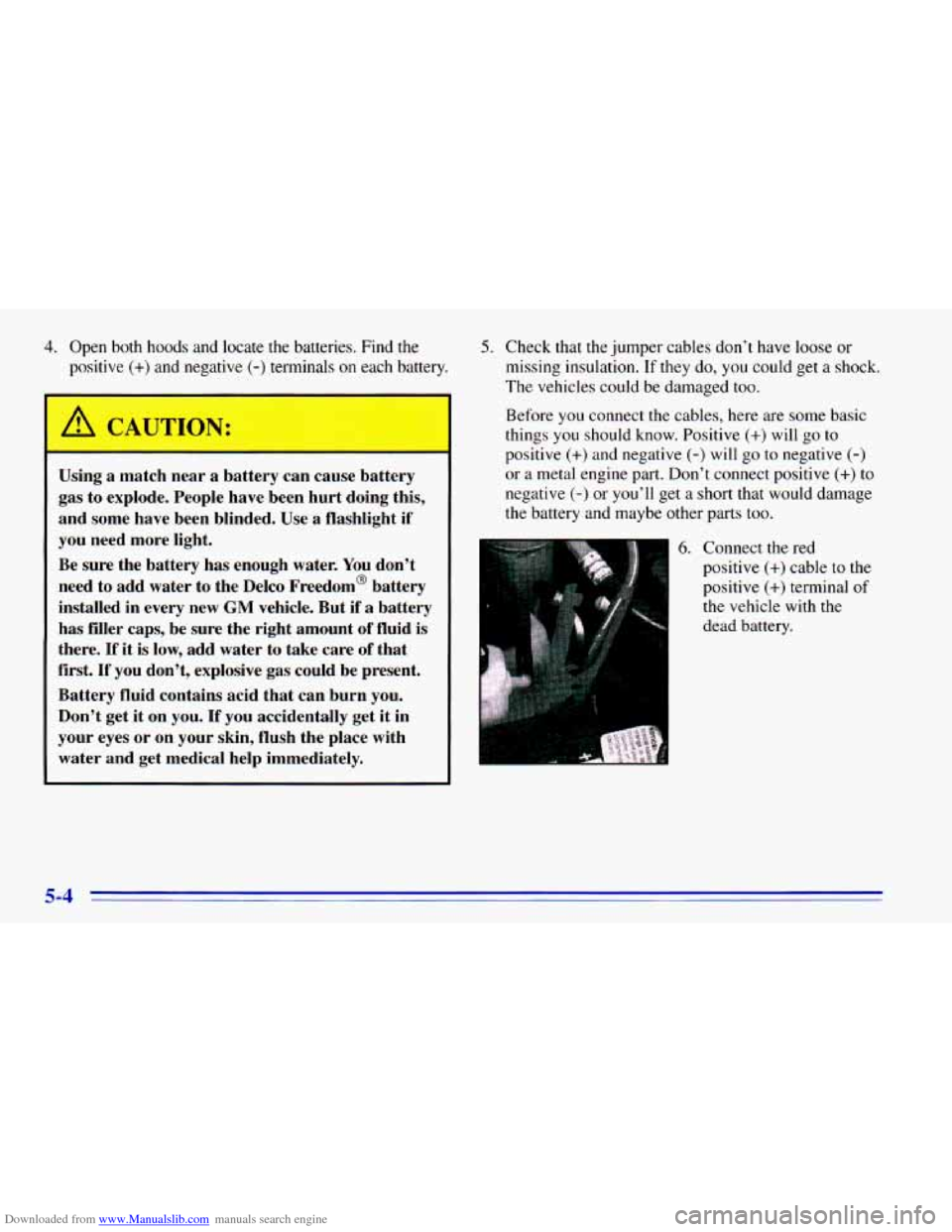Page 216 of 392

Downloaded from www.Manualslib.com manuals search engine 4. Open both hoods and locate the batteries. Find the
positive
(+) and negative (-) terminals on each battery.
Using
a match near a battery can cause battery
gas to explode. People have been hurt doing this,
and some have been blinded. Use
a flashlight if
you need more light.
Be sure the battery has enough water. You don’t
need to add water to the Delco Freedom’ battery
installed in every new
GM vehicle. But if a battery
has filler caps, be sure the right amount of fluid is
there. If it is low, add water to take care
of that
first. If you don’t, explosive gas could be present.
Battery fluid contains acid that can burn you.
Don’t get it on you.
If you accidentally get it in
your eyes or on your skin, flush the place with
water and get medical help immediately.
5. Check that the jumper cables don’t have loose or
missing insulation. If they do, you could get a shock.
The vehicles could be damaged too.
Before you connect the cables, here are some basic
things you should know. Positive
(+) will go to
positive
(+) and negative (-) will go to negative (-)
or a metal engine part. Don’t connect positive (+) to
negative
(-) or you’ll get a short that would damage
the battery and maybe other parts too.
6. Connect the red
positive
(+) cable to the
positive
(+) terminal of
the vehicle with the
dead battery.
5-4
Page 217 of 392
Downloaded from www.Manualslib.com manuals search engine 7. Don’t let the other
end touch metal.
Connect
it to the
positive
(+) terminal
of the good battery.
8.
Now connect the black
negative
(-) cable to
%
Don’t let the other end touch anything until the next
step. The other end
of the negative cable doesn’t go to
the dead battery. It goes to a heavy unpainted metal part
on the engine of the vehicle with the dead battery.
A Y. Attach the cable at least
18 inches
(45 cm) away
from the dead battery,
but
not near engine parts
that move.
The electrical connection is just
as good there, but
the chance
of sparks
getting back to the
battery is much less.
10. Now start the vehicle with the good battery and
run the engine for a while.
5-5
Page 218 of 392
Downloaded from www.Manualslib.com manuals search engine 11. Try to start the vehicle with the dead battery. If
it won’t start after a few tries make sure all
connections are good.
If it still won’t start, it
probably needs service.
12. Remove the cables in reverse order to prevent
electrical shorting. Take care that they don’t touch
each other or any other metal.
Fans or other moving engine parts can injure you
badly. Keep your hands away from moving parts
once the engines are running.
IA/
I-B
+
A. Heavy Metal Engine Part
B. Good Battery
C. Dead Battery
5-6
Page 383 of 392

Downloaded from www.Manualslib.com manuals search engine Coolant .............................. 5- 1 1. 6-22
Courtesy Transportation
........................... 8-6
Cruise Control ................................. 2-40
Customer Assistance Information
................... 8- 1
Customer Satisfaction Procedure .................. 8- 1
Coolant Heater. Engine .......................... 2- I5
Damage. Finish ............................... 6-55
Damage. Sheet Metal
............................ 6-55
Daytime Running Lamps
......................... 2-44
Daytime Running Lamps Indicator Light
............ 2-73
Dead Battery
................................... 5-2
Defensive Driving
............................... 4- I
Defogging ..................................... 3-4
Defrosting
................................ 3-4
DelcoLOCII
................................. 3-14
Dimensions. Vehicle
............................ 6-64
Dome Lamps
............ .................. 2-46
Door Defects. Reporting Safety
......................... 8-8
@ **
Locks ....................................... 2-3
Storage
..................................... 2-53
Drive. Automatic Transmission
.................... 2- I8
Drive Axle Service .............................. 7-52
Driver Position
................................. I - 12
Driving ........................................ 4-1
City
........................................ 4-34
Defensive
.................................... 4-1
Drunken
..................................... 4-2
Freeway
.................................... 4-35
Guidelines
.................................. 4- I4
Hill and Mountain Roads ....................... 4-38
InaBlizzard
................................. 4-41
In Foreign Countries ........................... 6-4
Night
...................................... 4-29
Off-Road
................................... 4-14
OnCurves
................................... 4-8
Rainy Conditions
............................. 4-31
Snowy and. Icy Conditions
...................... 4-40
Throughwater
............................... 4-33
Wet Roads
.................................. 4-31
Winter
...................................... 4-39
With a Trailer
................................ 4-51
Driving On Grades While Towing a Trailer
........... 4-53
Drunken Driving
................................ 4-2
Easy Entry Seat
................................ 1-6
Electrical Equipment. Adding
................ 3- 17. 6-58
Electrical System
............................... 6-58
Endgate
....................................... 2-7
Emergency Release
............................ 2-9
ManualRelease
............................... 2-8
Remote Release ............................... 2-9
Coolant Heater
............................... 2-15
Coolant Level Check
.......................... 7-47
Coolant Temperature Gage
..................... 2-69
FanNoise
................................... 5-20
Identification
................................ 6-57
OilLevelCheck
.............................. 7-47
Overheating ................................. 5-11
Specifications ................................ 6-63
Engine
........................................ 6-8
Exllaust
..................................... 2-32
Running While Parked
......................... 2-32
Starting
..................................... 2-13
9-3